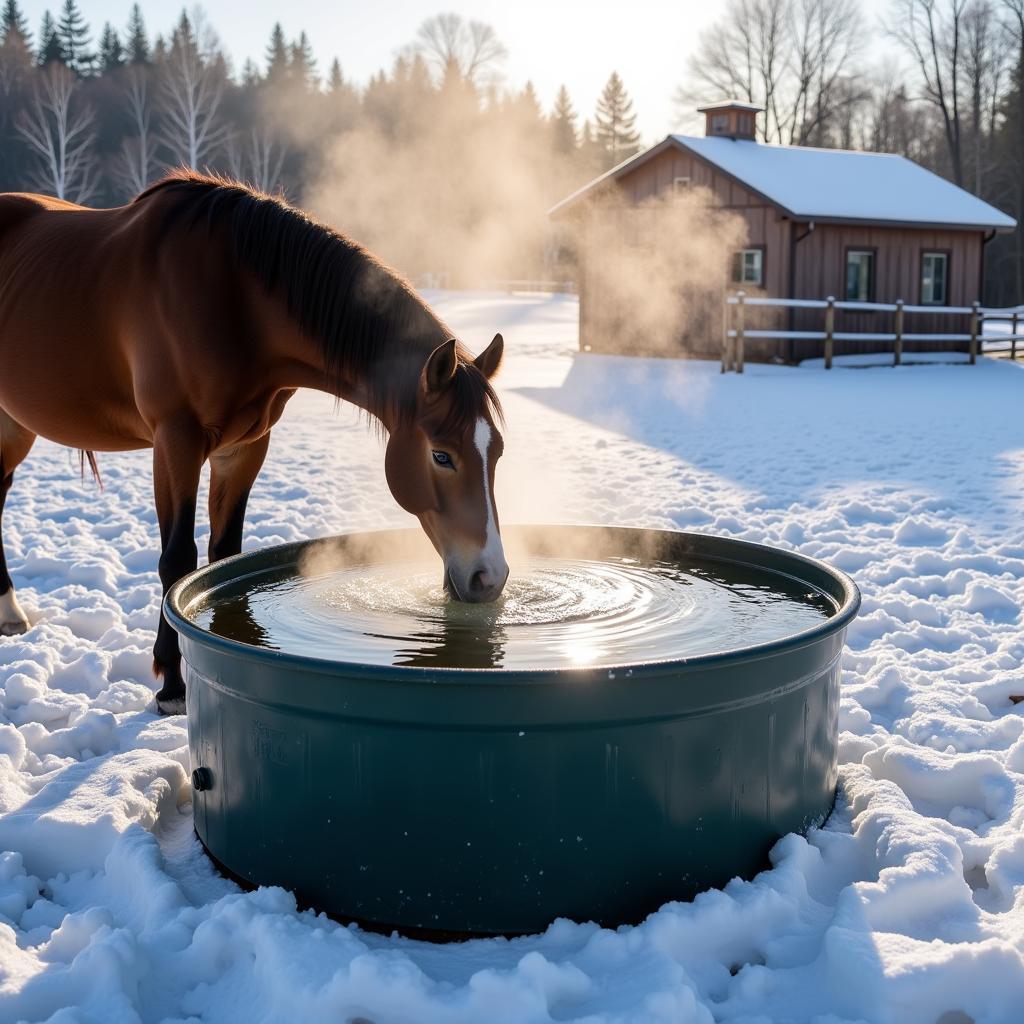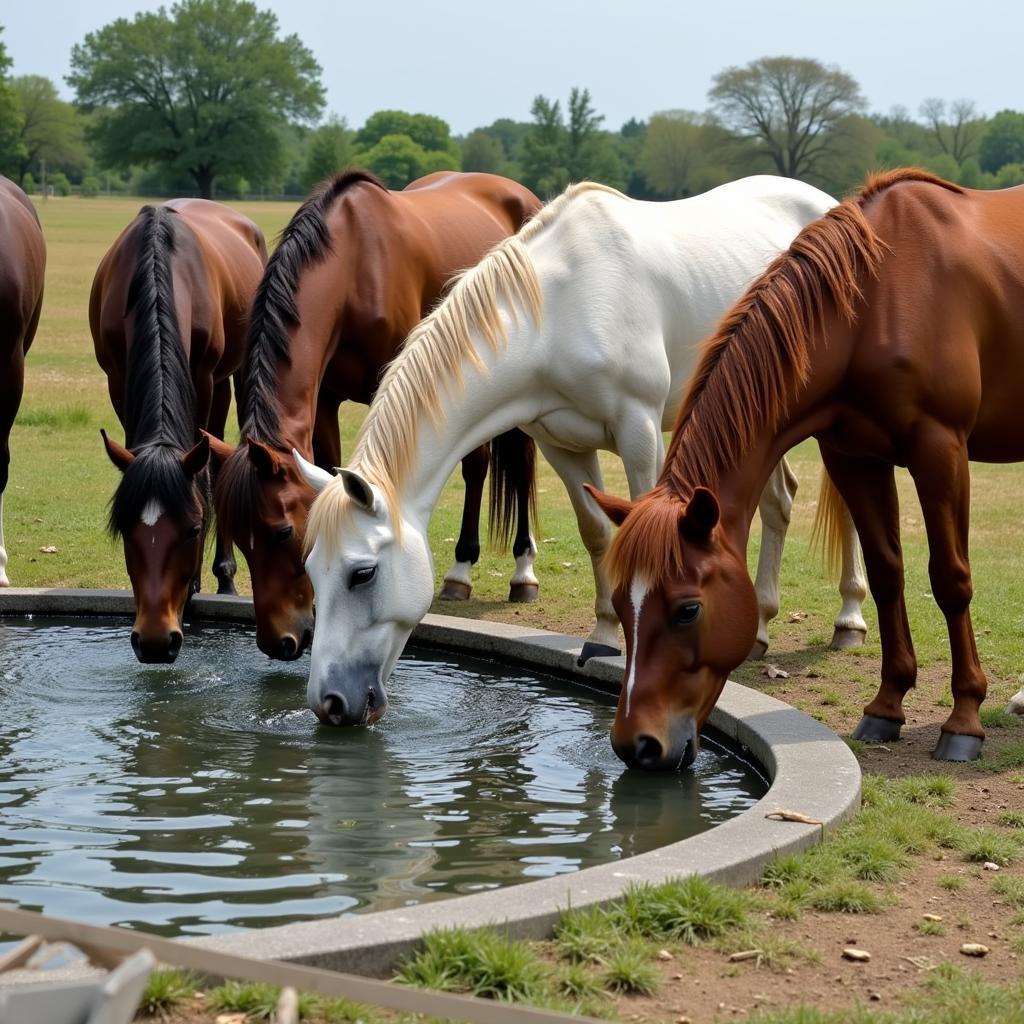Providing fresh, clean water is crucial for your horse’s health and well-being. A reliable Water Tub For Horses is a fundamental part of equine care, ensuring your horse stays hydrated and performs at its best. Choosing the right tub can be a daunting task with so many options available. This comprehensive guide will cover everything you need to know about selecting, installing, and maintaining the perfect water tub for your equine companion.
Choosing the Right Water Tub for Horses
Several factors influence the ideal water tub for your horses. Consider the size of your herd, the climate you live in, and your budget. Do you have a single horse or a large herd? This will determine the capacity you need. Live in a freezing climate? A heated water tub for horses might be essential. For those on a budget, a simple, durable plastic tub might suffice. A DIY slow feeder for horses can also be a great budget-friendly project for horse owners.
Material Matters: Durability and Safety
Water tubs are typically made from plastic, rubber, or galvanized steel. Each material has its pros and cons. Plastic tubs are lightweight and affordable, but can crack in extreme temperatures. Rubber tubs are more durable and less prone to cracking, but they can be heavier and more expensive. Galvanized steel tubs are the most durable option, but they can rust over time. Choose a material that best suits your needs and budget. Always prioritize safety by ensuring the tub has smooth edges and no sharp corners.
Sizing Up Your Water Needs
Horses drink a significant amount of water daily, especially during hot weather or after strenuous exercise. A general guideline is to provide 10-12 gallons of water per horse per day. However, factors like activity level, temperature, and diet can influence this amount. Ensure your chosen tub can comfortably accommodate your horses’ daily water intake.
Installation and Placement: Optimizing Accessibility and Cleanliness
Proper installation and placement are vital for ensuring your horses have easy access to clean water and minimizing maintenance. Choose a level location with good drainage to prevent mud and stagnant water buildup. Place the tub away from manure piles and other potential contaminants. Ensure the area around the tub is free of obstacles that could pose a tripping hazard.
Maintaining Cleanliness: Preventing Algae and Bacteria
Regular cleaning is essential to prevent the growth of algae, bacteria, and other harmful microorganisms. Scrub the tub thoroughly at least once a week with a stiff brush for horses and a mild detergent safe for animals. Rinse the tub thoroughly to remove all traces of soap. Periodically disinfect the tub with a solution of bleach and water, following the manufacturer’s instructions carefully.
Winter Care: Keeping Water Flowing in Freezing Temperatures
In colder climates, preventing water from freezing is crucial for your horses’ hydration. Heated water tubs for horses are a valuable investment in these conditions. They provide a consistent source of unfrozen water, ensuring your horses stay hydrated throughout the winter. Alternatively, you can use floating de-icers or stock tank heaters to keep the water from freezing. Remember to check the water regularly and break up any ice that may form.
 Heated Water Tub for Horses in Winter
Heated Water Tub for Horses in Winter
What size water tub do I need for my horse?
A good rule of thumb is 10-12 gallons per horse per day, but adjust based on individual needs and environmental factors.
What material is best for a horse water tub?
Plastic, rubber, and galvanized steel are common choices, each offering different levels of durability and cost.
How often should I clean my horse’s water tub?
Clean the tub thoroughly at least once a week, and disinfect periodically to prevent algae and bacteria growth.
How do I keep my horse’s water from freezing in the winter?
Heated water tubs, floating de-icers, and stock tank heaters are effective solutions for preventing water from freezing. You might also consider a horse lick tubs with fly control for added benefits during warmer months.
Preventing Water Tub Problems: Common Issues and Solutions
Sometimes, horses can be picky about their water. If your horse isn’t drinking enough, consider adding electrolytes or apple cider vinegar to make the water more palatable. Ensure the tub is placed in a comfortable and accessible location. Be mindful of dominant horses preventing others from accessing the water. If necessary, provide multiple water sources. Regularly check the water level and refill as needed. You may also need to address lazy horses and their specific needs when it comes to hydration. It’s always important to also watch out for potential problems like sand colic and utilize a sand purge for horses when necessary.
 Multiple Horses Drinking from a Water Trough
Multiple Horses Drinking from a Water Trough
“Providing clean, fresh water is the cornerstone of good horse care,” says Dr. Emily Carter, DVM, an equine veterinarian with over 20 years of experience. “A reliable water tub is an essential investment for any horse owner.”
“Remember,” adds Carter, “observing your horse’s drinking habits can provide valuable insights into their overall health. Changes in water intake can be an early indicator of illness.”
Conclusion: Investing in Your Horse’s Hydration
Choosing the right water tub for horses is an important decision that directly impacts their health and well-being. By carefully considering the factors outlined in this guide, you can select a water tub that meets your horse’s needs and ensures they stay adequately hydrated. Investing in a high-quality water tub for horses is an investment in your horse’s health and happiness.
Need assistance with horse care? Contact us at Phone: 0772127271, Email: [email protected] Or visit us at QGM2+WX2, Vị Trung, Vị Thuỷ, Hậu Giang, Việt Nam. We have a 24/7 customer service team.